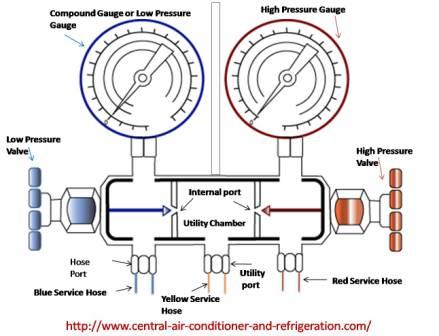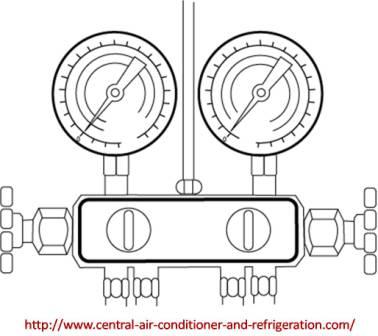Air conditioning gauges
This how AC gauge works?
What is air conditioning gauges manifold?
Air conditioner gauges is chamber device that is design to control the flows of pressure or gases. It holds both compound and high pressure.
This is what refrigeration manifold gauges look like:

The AC manifold gauges set have the three chambers: the low pressure chamber (left side), utility chamber (middle), and the high pressure chamber (right side).
When technicians connect the HVAC manifold gauge to the air conditioner units, he connects the low pressure side of air conditioner unit to low pressure gauge side.
If he wants to read the pressure in discharge line he connects the high pressure gauge hose to the air conditioner high pressure side.
The utility port (the middle chamber) is a place where we connect the hose to vacuum pump, recovery units or the port to add or remove refrigerant from AC units.
Air conditioning gauges is used to measure air conditioner units pressure within closed-system to evaluate or troubleshoot the central air units. Gauges manifold set is the most frequently used item when it comes to refrigerant or pressure.
Air conditioning gauge set allows the HVAC technician to check central air conditioning unit operating pressures, transfer Ac refrigerant, pressure test system, purge the system with nitrogen, and perform other necessary tasks.
The gauges manifold set includes the hoses, the manifold, the valves, the compound gauge (low pressure gauges) and high pressure gauge.
How does air conditioner gauges works?
We’ll learn how air conditioning gauges work from two-valve gauges (like the AC gauge picture above) and from a R-22 manifold gauge set.
The way an air conditioner gauges work is by open and closing the hand valve. Yeah, I’m serious. That is simply!
As we can see in AC gauge assembly above, it has needle and small port to the utility chamber from both high and low pressure chamber.
This needle and small port allow the refrigerant to flow from low pressure chamber to utility chamber or across from low pressure chamber to high pressure chamber.
To open the low pressure hand valves, we have to turn it counterclockwise. What we’re opening is the low pressure port to the utility chamber and to close the low pressure port to the utility chamber we have to turn it clockwise.
The way we open and close the high pressure hand valve is similar to compound gauge (low pressure gauge). We turn counterclockwise to open AC gauge and to close the gauge we turn clockwise.
When we connect low pressure hoses to air conditioner low pressure side (suction line), we’ll automatically read the pressure in the low pressure gauges without opening anything. It does the same with the high pressure side.
The reason we need to open the port to the utility chamber (hose) is to add or remove refrigerant, pull system on vacuum, or transfer refrigerant to cylinder. The utility hose is where these accessories are connected.
If we need to read the pressure and temperature of close-system, we’ll just connected HVAC gauges to central air conditioner.

HVAC gauges videos
Make sure to press the Play button in the player controls to watch it. Enjoy!
Air conditioner gauge training Videos made by DrZarkloff
What are the types of air conditioning gauges manifold set?
There are numerous manifold gauges, but we’ll be discussion two categories of manifold gauge.
- Standard two valve gauge manifold set
- Standard four valve gauge manifold set
Here is what a standard two-valve gauge manifold set looks like –

The two-valve gauge manifold set has the two hand valves and three hose ports. The hand valves are adjustable. We could adjust the hand valves to monitor the system pressures within the system.
Notes: this air conditioning gauges set has the two gauges: the high side gauge and the low side gauges. To monitor the high side of the air conditioner units we have to connect the hose to high side ports and to monitor from the low side of central air conditioning units we have to connect the hose to low side ports.
Here is what a standard four valve gauge manifold set looks like –

The advantage a four-valve has over two-valve is it has the two extra valves. These two extra valve allows the technician to connect to refrigerant cylinder and vacuum pump without disconnect the service hose (utility hose).
The four-valve ports are connected to:
- Refrigerant cylinder
- Low pressure
- High pressure
- Vacuum pump
Return to central air conditioner and refrigeration